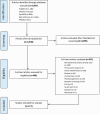A scoping review of social and behavioral science research to translate genomic discoveries into population health impact
- PMID: 32902617
- PMCID: PMC8240657
- DOI: 10.1093/tbm/ibaa076
A scoping review of social and behavioral science research to translate genomic discoveries into population health impact
Abstract
Since the completion of the Human Genome Project, progress toward translating genomic research discoveries to address population health issues has been limited. Several meetings of social and behavioral scientists have outlined priority research areas where advancement of translational research could increase population health benefits of genomic discoveries. In this review, we track the pace of progress, study size and design, and focus of genomics translational research from 2012 to 2018 and its concordance with five social and behavioral science recommended priorities. We conducted a review of the literature following the Preferred Reporting Items for Systematic Reviews and Meta-Analysis Guidelines for Scoping Reviews. Steps involved completing a search in five databases and a hand search of bibliographies of relevant literature. Our search (from 2012 to 2018) yielded 4,538 unique studies; 117 were included in the final analyses. Two coders extracted data including items from the PICOTS framework. Analysis included descriptive statistics to help identify trends in pace, study size and design, and translational priority area. Among the 117 studies included in our final sample, nearly half focused on genomics applications that have evidence to support translation or implementation into practice (Centers for Disease Control and Prevention Tier 1 applications). Common study designs were cross-sectional (40.2%) and qualitative (24.8%), with average sample sizes of 716 across all studies. Most often, studies addressed public understanding of genetics and genomics (33.3%), risk communication (29.1%), and intervention development and testing of interventions to promote behavior change (19.7%). The number of studies that address social and behavioral science priority areas is extremely limited and the pace of this research continues to lag behind basic science advances. Much of the research identified in this review is descriptive and related to public understanding, risk communication, and intervention development and testing of interventions to promote behavior change. The field has been slow to develop and evaluate public health-friendly interventions and test implementation approaches that could enable health benefits and equitable access to genomic discoveries. As the completion of the human genome approaches its 20th anniversary, full engagement of transdisciplinary efforts to address translation challenges will be required to close this gap.
Keywords: Genomics; Social and behavioral sciences; Translation.
© Society of Behavioral Medicine 2020. All rights reserved. For permissions, please e-mail: journals.permissions@oup.com.
Figures




Similar articles
-
The future of Cochrane Neonatal.Early Hum Dev. 2020 Nov;150:105191. doi: 10.1016/j.earlhumdev.2020.105191. Epub 2020 Sep 12. Early Hum Dev. 2020. PMID: 33036834
-
Beyond the black stump: rapid reviews of health research issues affecting regional, rural and remote Australia.Med J Aust. 2020 Dec;213 Suppl 11:S3-S32.e1. doi: 10.5694/mja2.50881. Med J Aust. 2020. PMID: 33314144
-
Impact of summer programmes on the outcomes of disadvantaged or 'at risk' young people: A systematic review.Campbell Syst Rev. 2024 Jun 13;20(2):e1406. doi: 10.1002/cl2.1406. eCollection 2024 Jun. Campbell Syst Rev. 2024. PMID: 38873396 Free PMC article. Review.
-
Recovery schools for improving behavioral and academic outcomes among students in recovery from substance use disorders: a systematic review.Campbell Syst Rev. 2018 Oct 4;14(1):1-86. doi: 10.4073/csr.2018.9. eCollection 2018. Campbell Syst Rev. 2018. PMID: 37131375 Free PMC article.
-
Public sector reforms and their impact on the level of corruption: A systematic review.Campbell Syst Rev. 2021 May 24;17(2):e1173. doi: 10.1002/cl2.1173. eCollection 2021 Jun. Campbell Syst Rev. 2021. PMID: 37131927 Free PMC article. Review.
Cited by
-
Strategies to Integrate Genomic Medicine into Clinical Care: Evidence from the IGNITE Network.J Pers Med. 2021 Jul 8;11(7):647. doi: 10.3390/jpm11070647. J Pers Med. 2021. PMID: 34357114 Free PMC article.
-
Epigenetics and the International Classification of Functioning, Disability and Health Model: Bridging Nature, Nurture, and Patient-Centered Population Health.Phys Ther. 2022 Jan 1;102(1):pzab247. doi: 10.1093/ptj/pzab247. Phys Ther. 2022. PMID: 34718813 Free PMC article.
-
Public Health Genomics: Time to Sharpen the Focus.Public Health Genomics. 2023;26(1):171-176. doi: 10.1159/000533985. Epub 2023 Sep 20. Public Health Genomics. 2023. PMID: 37729876 Free PMC article. No abstract available.
-
Using a behaviour-change approach to support uptake of population genomic screening and management options for breast or prostate cancer.Eur J Hum Genet. 2025 Jan;33(1):108-120. doi: 10.1038/s41431-024-01729-1. Epub 2024 Nov 12. Eur J Hum Genet. 2025. PMID: 39532988
-
Advancing precision public health using human genomics: examples from the field and future research opportunities.Genome Med. 2021 Jun 1;13(1):97. doi: 10.1186/s13073-021-00911-0. Genome Med. 2021. PMID: 34074326 Free PMC article.
References
-
- National Human Genome Research Institute. The cost of sequencing a human genome. 2019; Available at https://www.genome.gov/about-genomics/fact-sheets/Sequencing-Human-Genom.... Accessibility verified November 1, 2018.
-
- Best A, Hiatt RA, Norman CD. Knowledge integration: Conceptualizing communications in cancer control systems. Patient Educ Couns. 2008;71(3):319–327. - PubMed
-
- Leavitt M. Medscape’s response to the institute of medicine report: Crossing the quality chasm: a new health system for the 21st century. MedGenMed. 2001;3(2):2. - PubMed
Publication types
MeSH terms
Grants and funding
LinkOut - more resources
Full Text Sources
Research Materials
Miscellaneous

